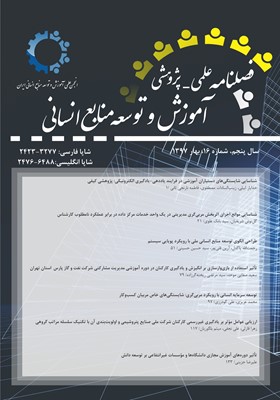شناسایی و تبیین ابعاد، مؤلفهها و شاخصهای ارزیابی سیستم مدیریت یادگیری الکترونیک در بانک مسکن
محورهای موضوعی :
علیرضا نصیری نیا
1
,
امیرحسین محمودی
2
,
یلدا دلگشایی
3
,
علی رضا بادله
4
![]()
1 - دانشکده روانشناسی و علوم تربیتی دانشگاه آزاد واحد تهران مرکزی
2 - دانشگاه آزاد اسلامی واحد تهران مرمز
3 - دانشگاه آزاد اسلامی واحد علوم و تحقیقات
4 - دانشگاه آزاد اسلامی واحد علوم و تحقیقات
کلید واژه: آموزش الکترونیکی, ارزیابی, سیستم مدیریت یادگیری الکترونیکی ,
چکیده مقاله :
هدف از پژوهش حاضر، شناسایی و تبیین ابعاد، مؤلفهها و شاخصهای ارزیابی سیستم مدیریت یادگیری الکترونیکی در بانک مسکن میباشد. روش پژوهش به لحاظ هدف، کاربردی و به لحاظ نحوه گردآوری اطلاعات، از نوع کیفی است. در این تحقیق پس از نمونهگیری هدفمند، فرایند مصاحبه با خبرگان کلیدی و مطلع تا هنگام شناسایی و توصیف کامل ابعاد، مؤلفهها و شاخصها و حصول اشباع نظری استمرار یافت. برای تعیین چارچوب منطقی از مجموع دادههای گردآوری شده، مراحل شناسایی، یادداشت برداری و طبقهبندی مفاهیم انجام شد. بدین منظور اطلاعات بدست آمده تجمیع و متون مورد بررسی مجدد قرار گرفته و بصورت دستههای عمدهتر طبقهبندی شد. در نهایت، دستهها بازبینی و موارد تکراری حذف، موارد مشابه و کوچکتر ادغام و ابعاد موضوع مشخص و در چارچوب مؤلفهها و شاخصهای بدست آمده سطحبندی شدند. بر اساس نتایج حاصله، مدل استخراجی دارای 4 بُعد، 5 مؤلفه و 30 شاخص برای ارزیابی سیستم مدیریت یادگیری الکترونیکی میباشد. پس از نهایی شدن تحلیل دادهها و استخراج مدل مفهومی، به منظور سنجش اعتبار مدل با 10 نفر از خبرگان و صاحب نظران بانک در قالب یک گروه کانونی درخصوص ابعاد، مؤلفهها و شاخصهای مدل هماندیشی و توافق صورت پذیرفت.
The purpose of this study was to identify and explain the dimensions, components and indicators of the electronic learning management system in the Maskan Bank. The research method is applied in terms of purpose, and in terms of how information is collected, it is qualitative. In this research, after the purposeful sampling, the process of interviewing with key and informed experts until the identification and full description of the dimensions, components and indicators, and the achievement of theoretical saturation persisted. To determine the logical framework of the total collected data, the steps were taken to identify, note and classify the concepts. For this purpose, the collected data were aggregated and the texts were re-examined and categorized as major categories. Finally, the categories were reviewed, repetitive deletions, similar and smaller mergers, and the dimensions of the specified topic were ranked within the framework of the components and indicators. Based on the results, the extracted model has 4 dimensions, 5 components and 30 indicators for assessing the electronic learning management system. After finalizing the data analysis and extracting the conceptual model, in order to measure the validity of the model with 10 experts and experts of the bank in the form of a focal group about the dimensions, components and indicators of the model of consensus and agreement.
